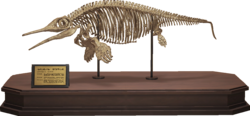Ophthalmosaurus
The Ophthalmosaurus is a two-part fossil that can be donated to the museum in Animal Crossing: New Horizons.
Donating to the museum[edit]
In New Horizons[edit]
When the player donates to Blathers or selects "Tell me about this!" in New Horizons, he will provide the following information about the fossil:
The Ophthalmosaurus can be found in the second room of the fossil exhibit in the museum.
As an item[edit]
In New Horizons[edit]
| Ophthalmo skull | |
|---|---|
| Interactable | No |
| Sell price | |
| Colors | Brown
Brown
|
| Size | |
| Ophthalmo torso | |
|---|---|
| Interactable | No |
| Sell price | |
| Colors | Brown
Brown
|
| Size | |
Real-world information[edit]
Ophthalmosaurus (meaning "eye lizard" in Greek) is an ichthyosaur of the Middle Jurassic period (165-160 million years ago), named for its extremely large eyes. It had a graceful 6 m (19.5 ft) long dolphin-shaped body, and its almost toothless jaw was well adapted for catching squid. Major fossil finds of this genus have been recorded in Europe and North and South America.
Ophthalmosaurus had a body shaped like a tear-drop and a caudal fin like a half-moon. Its forelimbs were more developed than the hind ones, which suggests that the front fins did the steering while the tail did the propelling. Ophthalmosaurus's chief claim to fame is its eyes (some reaching about 9 inches or 220–230 mm in diameter) which were extremely large in proportion to its body. The eyes occupied almost all of the space in the skull and were protected by bony plates (sclerotic rings), which most likely assisted to maintain the shape of the eyeballs against water pressure at depth. The size of the eyes and the sclerotic rings suggests that Ophthalmosaurus hunted at a depth where there is not much light or that it may have hunted at night when a prey species was more active.
More information on this topic is available at Wikipedia.
Gallery[edit]
| Fossils | ||||||||||||||||||||||||
|---|---|---|---|---|---|---|---|---|---|---|---|---|---|---|---|---|---|---|---|---|---|---|---|---|
| ||||||||||||||||||||||||


